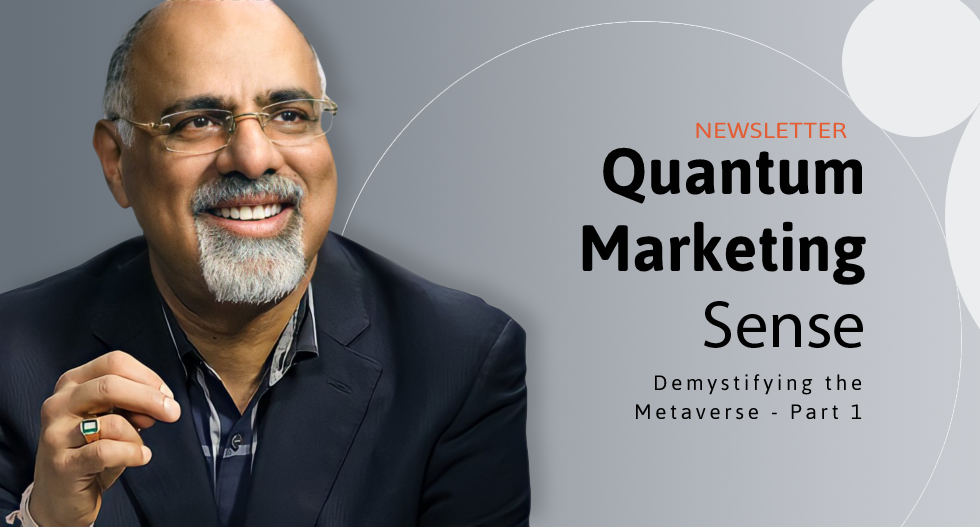THE TOPLINE
Metaverse is an incredibly hot topic right now – everyone is talking about it, in marketing and beyond. While metaverse existed as a concept for many years, public attention increased more recently and dramatically, with some big investments being made in this space and events like Meta (formerly Facebook) announcing their recent name change.
While metaverse is just one piece of the upcoming technological big bang, it could have a profound impact on marketing. In this two-part newsletter, I will attempt to demystify the metaverse: what it is, why it will be transformational, and how marketers must prepare to thrive in this new dimension
METAVERSE 101
There isn’t yet a standard industry definition of metaverse, and there are many competing views. But put simply, metaverse is any environment/space you engage in, virtually. Any large-scale virtual space containing experiences that are enabled by powerful technologies such as AR, VR, AI, and 5G is a part of the metaverse. I find it helpful to think of metaverse as an alternate universe in the digital/cyber space, that is very immersive. Here, you are not simply looking at a virtual world, but you are actually taken into that virtual world.
Metaverse can be entirely virtual, but it can also be mixed. Mixed realities are combinations of physical and virtual worlds or a certain level of convergence between between them.
Metaverse is not singular. In other words, there is not just one metaverse. Anyone with the necessary wherewithal can create their own metaverse. And you can go to any metaverse you choose and engage within it.
There were many early precursors to the metaverse, such as video games like The Sims or Second Life. In these games, you build your own village or city, rent property, and customize your world. The metaverse is that kind of an alternate reality, but with deep immersion. Instead of looking at a computer screen, you will be transported from the physical world into a virtual world that contains a high level of realism.
The immersive experience happens by combining the enormous capabilities of computing power with new platforms (such as the gaming engine Roblox) and rapidly evolving technologies like VR, AR and AI. The immersion and interaction is made very realistic, by creating instantaneous responses in the virtual environment to your physical movement/actions in the real world. Today, to enter the virtual worlds, you typically put on a headset.
We will be rapidly approaching a time when the gap between virtual worlds and the physical world will narrow significantly. In many ways, because the virtual worlds will look so realistic, it will be difficult for your brain to distinguish what is physically real and what is only virtual, in that environment. More of that later…
THE METAVERSE NOW
The possible applications of metaverse are immense. Here are a few areas where metaverse is beginning to take roots and making a difference.
- Learning, research, and training. Imagine you need to understand how a particular machine works. You can explore it, disassemble it and reassemble it in the metaverse and get a deep grasp about that machine. Likewise, medical students can do virtual surgeries, so they can practice their dissections without any risk.
- Interactive meetings. Many platforms are building out capabilities to do virtual meetings, with meeting participants’ avatars in virtual workspaces, allowing them to interact with their peers and colleagues with a higher level of engagement. I look at this as the next evolution of Zoom or Microsoft Teams meetings.
- Tourism. You can visit a popular tourist destination (or a totally fictional place) and explore it thoroughly and in a highly immersive fashion. Some tourism companies are already actively exploring this opportunity.
- Gaming and fitness. Virtual gaming is already mainstream. We are also starting to see utilitarian games that require calibrated exercises in order to continue (ie, requiring push-ups where the system measures if you bent down far enough to move onto the next step). We are gaining a level of exceptional quality where virtual games are so exciting that people spend more time on them than their laptop or traditional gaming console. In fact, gaming and fitness are proving to be the early killer apps for the metaverse.
These early examples are just the beginning. A mind boggling array of use cases and applications is coming our way, pretty rapidly.
THE METAVERSE IN THE FUTURE
We are just beginning to scratch the surface on potential use cases for these virtual worlds. Many are natural, immersive extensions of trends we started seeing during the pandemic, including:
- Social media. These days, it can be exceedingly difficult to gather your friends at a particular restaurant. Not so in the metaverse. Our avatars can meet up in a particular place, interacting in a new kind of social engagement.
- Entertainment. Say goodbye to venue limitations — now artists can reach millions of consumers at once. If each guest pays a tiny amount (say $1), the artists are much better off while also being free to control their agenda. For consumers, it’s a new and unique way to get close to their favorite artists.
- Sports. Imagine having the opportunity to stand on the sidelines and watch your favorite team compete. Soon, this could be the norm!
- Live events. Unable to take time off work to travel to that wedding across the country? Worry no more — you can still take part in the festivities remotely, all while feeling like you’re actually there.
All in all, metaverse represents a fascinating opportunity for creators, companies and consumers. And extraordinary scope for business and commerce. In the next part of this newsletter, I’ll talk about what this all means for marketers and how they can best prepare.

Recent Comments